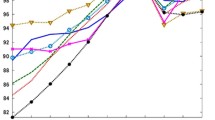
Overview
Presents the first English account of the Japanese banking crisis written by a Japanese regulator
Contains full of practical lessons based on experience
Invites readers to conceive policies in view of the whole financial cycle
Shows stumbling blocks in the transition from export-led to domestic demand-led growth
Provides a concise and readable narrative and analysis
Is an open access book
Buy print copy
Tax calculation will be finalised at checkout
About this book
This open access book provides a readable narrative of the bubbles and the banking crisis Japan experienced during the two decades between the late 1980s and the early 2000s. Japan, which was a leading competitor in the world’s manufacturing sector, tried to transform itself into an economy with domestic demand-led mature growth, but the ensuing bubbles and crisis instead made the country suffer from chronicle deflation and stagnation. The book analyses why the Japanese authorities could not avoid making choices that led to this outcome. The chapters are based on the lectures to regulators from emerging economies delivered at the Global Financial Partnership Center of the Financial Services Agency of Japan.
Similar content being viewed by others
Keywords
Table of contents (7 chapters)
-
Front Matter
-
Back Matter
Reviews
“Himino Ryozo has provided analysis of the 97-98 Japanese banking crisis that is clear, concise and compelling. Himino-san examines the causes, consequences and – most importantly – the lessons learnt from a traumatic period in Japanese financial history. He does so with the benefit of a career spent at the forefront of financial policy-making, both in Japan and internationally. It is often said ‘History doesn’t repeat itself, but it often rhymes.’ Many attributes of the Japanese banking crisis have, at their heart, difficult choices, missed opportunities and occasional failings that are in no way unique to Japan. Himino-san’s examination of the Japanese crisis should therefore be valued reading not just for Japanese policymakers, but financial policymakers the world over. Financial crises are all-too-frequent, and extremely costly. This analysis provides useful insights as to how we might do better to reduce and combat the crises of the future.” (Wayne Byres, Chair, Australian Prudential Regulation Authority)
Authors and Affiliations
About the author
Himino Ryozo is the Commissioner of the Financial Services Agency, Japan’s integrated financial regulator, and the Chair of the Financial Stability Board’s Standing Committee on Supervisory and Regulatory Cooperation, a global forum of regulatory authorities, central banks, finance ministries, and standard-setting bodies. He served as the Secretary General of the Basel Committee on Banking Supervision from 2003 to 2006 and helped the Committee finalize the Basel II capital adequacy standards. He graduated from the University of Tokyo (LL.B.) and Harvard Business School (M.B.A.).
Bibliographic Information
Book Title: The Japanese Banking Crisis
Authors: Ryozo Himino
DOI: https://doi.org/10.1007/978-981-15-9598-1
Publisher: Palgrave Macmillan Singapore
eBook Packages: Economics and Finance, Economics and Finance (R0)
Copyright Information: The Editor(s) (if applicable) and The Author(s) 2021
License: CC BY-NC-ND
Hardcover ISBN: 978-981-15-9597-4Published: 08 January 2021
eBook ISBN: 978-981-15-9598-1Published: 07 January 2021
Edition Number: 1
Number of Pages: XI, 121
Number of Illustrations: 20 b/w illustrations
Topics: Macroeconomics/Monetary Economics//Financial Economics, Development Finance, Economic History, Political Economy/Economic Systems



